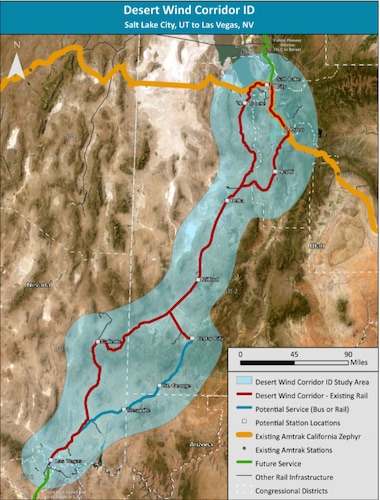To understand how best a passenger rail service could connect Salt Lake City to Las Vegas and Boise, Utah transportation officials first need a pile of federal dollars to study the issue.
They’ve asked for it: the Utah Department of Transportation applied for a $500,000 grant earlier this year. Whether or not they will receive it hasn’t been announced, but a decision is expected in the coming weeks, officials said Friday.
UDOT specifically filed its grant application with the Corridor Identification and Development Program — a Federal Rail Administration initiative intended to create a pipeline of intercity passenger rail projects. It was created after the 2021 passage of the federal Bipartisan Infrastructure Law, which invested in rail improvement.
The department’s application proposed a new rail service between Salt Lake City and Las Vegas; Utah transportation officials also partnered with Idaho’s state transportation agency on a proposal for rail service there, connecting Boise and Salt Lake City.
UDOT calls its portion of the proposal the “Desert Wind Corridor,” and on Friday, regional transportation officials gathered to discuss next steps, assuming they will receive the funding to move forward.

(Utah Department of Transportation) UDOT applied for a $500,000 grant that would fund an exploratory look at rail service between Salt Lake City and Las Vegas.
Getting the money doesn’t guarantee rail service. It only guarantees that officials will be able to spend time and resources more closely examining what it could look like, said Caroline Decker, national rail business director for WSP USA, a consulting group that develops intercity passenger rail strategy.
“This part is essential,” said Decker, who previously served as vice president of Amtrak’s Northeast Corridor Service Line. “Bringing together the planners, the engineers, the designers, and the stakeholders to really determine what’s best for Utahns. ... Once you really get to this point, you start to build that momentum to get to that next phase.”
The Federal Rail Administration aims to pick projects that will impact cities and markets underserved by rail service, while also weighing what kind of local support already exists for such projects to move to the next level, Decker said.
About 90 grant applications were submitted to the administration. Once projects are selected, the administration will partner with application sponsors on a service development plan, Decker said. That will better identify things like costs, concepts and forecasted demand for proposed service, according to the administration.
Decker thinks Utah is primed and ready for more intercity rail, and cited the amount of growth, beauty and successful transit already here.
Should the grant be approved, the public will likely be able to comment on their preferences for the proposed systems during the analysis process, Utah Transit Authority executive director Jay Fox said.
“I like the concept of putting this region, this service area right in the middle of the discussion for a larger intercity presence,” Fox said, “which will ultimately give people more opportunities to take modes of transportation that are not available to them right now.”
A UDOT presentation in June estimated that travel time between Salt Lake City and Las Vegas would likely be between 7 and 9.5 hours each way, based on previous Amtrak service that was discontinued in 1997, according to a UDOT presentation.
The other project, which would connect Caldwell, Idaho, to Salt Lake City, is estimated at at 7.5 hours of travel time each way, with additional stops — like Boise and Ogden — included along the proposed route.
For now, UTA is acting as a facilitator between transit agencies across the region, so they can be ready to work together if and when federal funding is approved.








